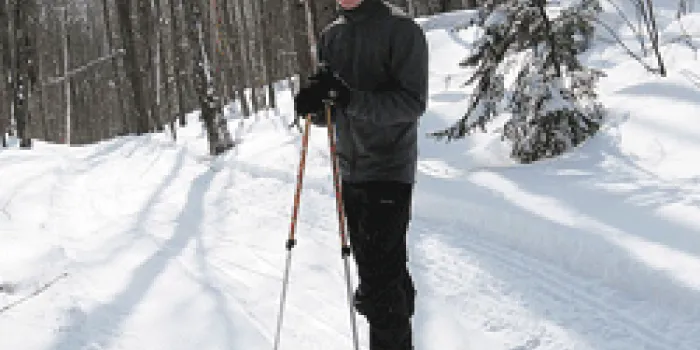Norwegians know the secret to surviving winter: gliding over a pristine snowscape on cross-country skis. “I started cross-country skiing at a very young age, almost as soon as I could walk,” says Skylar Lobdell, 20, in an email exchange from the University of St. Andrews, Scotland, where he is pursuing a degree in marine biology. He has severe hemophilia A and learned the sport at a ski center near his home in Elmore, Vermont. “I haven’t had any serious bleeds in years, but I think this is because I am very careful to administer my prophylactic treatments every other day,” he says.
Health benefits
The benefits of cross-country skiing are legion: cardiovascular workout; low-risk, low-impact exercise; easy to learn; no age limit; affordable and accessible. There are hundreds of Nordic centers in the US where you can ski on groomed trails, as well as golf courses and public parks. And cross-country skiing is the perfect antidote to cabin fever. “Skiing is great because it allows you to get out and experience the beauty of a winter’s day,” Lobdell says.
Cross-country skiing is an aerobic sport. The motion for the classic style, in which your skis are straight in front of you, is a push, kick and glide. Your feet are shoulder length apart, with your knees bent and your weight forward. You plant your poles and push back, with your heel coming off the back of the ski as you glide through. “Your legs are getting the brunt of it because they’re doing the actual movement,” says Sharon Funk, PT, DPT, University of Colorado Denver Hemophilia and Thrombosis Center. “But you’re also using your upper extremities to push yourself along as well, especially going uphill or on level ground.” Adults can burn 400 calories or more per hour while cross-country skiing, according to the American College of Sports Medicine (ACSM).
Equipment
You can either rent equipment at a ski resort or purchase your own. Beginners should choose waxless skis and boots with good ankle support. Step-in bindings make it simple to press down with the tip of the boot onto clips fastened on the skis. Poles should be strong and lightweight, reaching your armpit. Make sure the straps rest between your thumb and fingers.
Dress for success
Dressing in layers is the secret to being comfortable while cross-country skiing. The base layer closest to your body should keep you warm and wick away sweat. The ACSM recommends synthetics, such as polypropylene and polyester. Sheep don’t shiver in the cold, and neither should you. “Wool can maintain its thermal properties even when it’s wet,” Funk says.
The middle layer should insulate and transport moisture away from the body, so wear wool or a fleece vest. A lightweight jacket that is wind- and waterproof provides the best outer layer. Ski pants, not jeans, are the best leg coverings. Prevent heat loss from your head by wearing a fleece or wool hat that covers your ears. Sunglasses with ultraviolet (UV) protection will keep the sun glare off the snow from interfering with your vision.
The condition of your hands and feet can make or break your ski trek. “Avoid wearing cotton socks because if you get wet, then you can’t dry out and you get chilled,” says Funk. Instead, wear wool or microfiber socks, she says. Gloves work best for gripping your poles, but mittens keep your fingers warmer. Bring an extra pair if your hands sweat or get wet.
Precautions and preparations
Before hitting the trails, do some warm-ups. “You need to be stretching all of your lower-extremity muscle groups—your quads and hamstrings, your calves and your gluteal muscles,” Funk says. For your upper body, stand with your arms raised overhead and feel the stretch in your upper back and arms, she says.
Compared with downhill skiing, cross-country may look tame, but it’s not. “It is very demanding. You absolutely should have your factor on the day you go,” Funk says. “And don’t ski on terrain that is too difficult for you.” At a Nordic center with marked trails, choose the green (easy) vs. the blue or red, which are moderate and difficult, respectively.
A backpack is essential. “If I’m going on an all-day trip or a multiday trip, where I might camp out, I carry a bag with all of my supplies, including factor,” Lobdell says. “Always carry water, because you’re going to be very thirsty,” Funk adds. A first-aid kit, flashlight or headlamp, hand warmers, sunscreen and extra clothes come in handy.
When hunger hits, high-quality snacks are a must. “Your best bet is to have a combination of protein for endurance and carbs for energy,” says Funk. Fruit and nuts, granola and trail mix provide carbohydrates; an energy bar packs protein.
Safe skiing
According to the National Hemophilia Foundation’s publication “Playing It Safe: Bleeding Disorders, Sports and Exercise,” cross-country skiing is rated “a moderate risk sport.” With that in mind, groomed trails are safer for new skiers. If you have arthritic joints or balance issues, stay on a flat surface without hills and simply walk on the skis, says Funk. “Under these conditions, cross-country skiing can be very safe. You can scoot along at a very slow pace. There’s minimal risk of injury,” she says.
However, falls happen. Cross-country skis are narrow and can be difficult to control. Turning can be tough. “If you can, try to sit down to the side and plunk yourself down on your derriere,” which has lots of padding to protect you, Funk says. “I’ve had some good bruises and sore muscles from skiing mishaps,” Lobdell admits. “But as long as you are paying attention to your surroundings, it is really quite low-risk.”
This winter, instead of daydreaming about cross-country skiing, find a Nordic center and take the family. “There are few things as serene as the sun glinting off the snow on the tree branches, when the only sound is your skis gliding across the snow,” Lobdell says.

